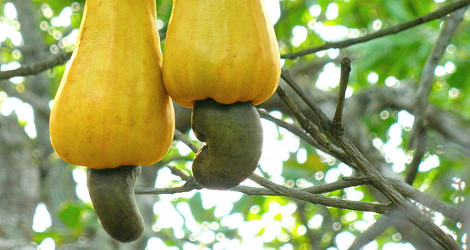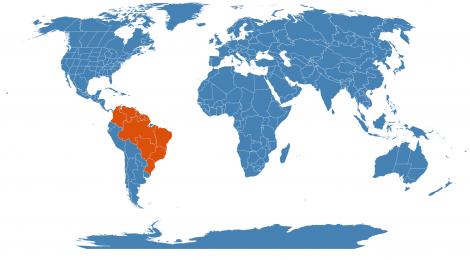Accession Data:
Anacardium occidentale L.
- Common Name: Cashew Nut Tree
- Family: Anacardiaceae Lindl.
- Description:
- Uses: The Cashew Nut is otherwise known as Venamra or Vrikkaphala in Sanskrit and is used to fulfill a healhty lifestyle. The nut is contains low cholesterol, low fat very beneficial to the heart and rich antioxidants and protein. Cashew nut pacifies agitated Vatha and Kapha. It is great in preventing skin diseases, dysentery, and hemorrhoids. Strengthens hair and nails, and will aid in warm infestation.
Traditionally, extractions with cashew are used to care for oral hygiene. It is used to prevent gingivitis, cavities, periodontal and many other oral infections through it's antimicrobial properties. More studies are being conducted to verify the true potential of these hygienic properties 7.
- IMPORTANT NOTE: Plant Uses are for informational purposes only. EEB Greenhouses assume no responsibility for adverse effects from the use of any plants referred to on this site. Always seek advice from a professional before using any plant medicinally.
- USDA Zone: 9a-11
Accession Data:
- Accession # 200900052
- Source: Top Tropicals
- Accession Date: 05-13-2009
- Bench: 1311 - NEOA: Ground Bed 1 SE
- Currently: active - healthy
- Qty: 1 confirmed on 10-08-2024
Classification:
- Division: Magnoliophyta
- Class: Magnoliopsida
- SubClass: eurosid II
- Order: Sapindales
- SubOrder:
- Family: Anacardiaceae
- SubFamily: Anacardioideae
- Tribe:
- SubTribe:
Flowering Data:
This accession has been observed in bloom on:| Year | Jan | Feb | Mar | Apr | May | Jun | Jul | Aug | Sep | Oct | Nov | Dec | ||||||||||||||||||||||||||||||||||||||||
|---|---|---|---|---|---|---|---|---|---|---|---|---|---|---|---|---|---|---|---|---|---|---|---|---|---|---|---|---|---|---|---|---|---|---|---|---|---|---|---|---|---|---|---|---|---|---|---|---|---|---|---|---|
| 2024 | ||||||||||||||||||||||||||||||||||||||||||||||||||||
| 2023 | ||||||||||||||||||||||||||||||||||||||||||||||||||||
| 2022 | ||||||||||||||||||||||||||||||||||||||||||||||||||||
| 2021 | ||||||||||||||||||||||||||||||||||||||||||||||||||||
| 2020 | ||||||||||||||||||||||||||||||||||||||||||||||||||||
| 2019 | ||||||||||||||||||||||||||||||||||||||||||||||||||||
| 2018 | ||||||||||||||||||||||||||||||||||||||||||||||||||||
| 2017 | ||||||||||||||||||||||||||||||||||||||||||||||||||||
| 2016 | ||||||||||||||||||||||||||||||||||||||||||||||||||||
| 2015 | ||||||||||||||||||||||||||||||||||||||||||||||||||||
References (internal):
- Medicinal Plants - Ayurveda Medicine
- Plants with Extrafloral Nectaries
- EEB 3271 - Systematic Botany
- Medicinal Plants - Integumentary System
- Medicinal Plants - Circulatory System
- Medicinal Plants - Digestive System
- Medicinal Plants - Immune System
- Medicinal Plants - Traditional African Medicine
- Scavenger Hunt - Grades 9-12 (generic)
- Accessions with Embedded Video Files
- EEB Greenhouse Holdings native to: French Guiana / Guyana / Suriname / Venezuela / Colombia / Brazil West-Central / Brazil Northeast / Brazil Southeast / Brazil North / Brazil South
References (external):
- Wikipedia
- Ayurvedic Medicinal Plants
- The Plant List (2013). Version 1.1. Last accessed on Tuesday, April 25, 2017.
- Anacardium occidentale at ARS-GRIN. Last accessed on Tuesday, April 25, 2017.
- Image#00 (cropped) courtesy Abhishek Jacob, 2009 from Wikimedia Commons. Creative Commons Attribution-Share Alike 3.0 Unported. Last accessed on Wednesday, June 21, 2017.
- Anacardium occidentale at Catalogue of Life. Last accessed on Wednesday, June 21, 2017.
- In vitro antimicrobial and cytotoxic effects of Anacardium occidentale and Mangifera indica in oral care . G. Anand, M. Ravinanthan, R. Basaviah, and A. Veena Shetty. J Pharm Bioallied Sci. 2015 Jan-Mar; 7(1): 69–74. Last accessed on Thursday, March 29, 2018.
data regenerated on Tue, 08 Oct 2024 13:02:23 -0400 [bcm v4.0]
Images:

Additional images for this accession:
Click on thumbnails to enlargeCurrent Accessions in the Anacardiaceae
Subfamily Anacardioideae
Subfamily Spondiadoideae
W/C = Wild Collected = indicates flowering in past 14 days
= indicates flowering in past 14 days
 = images available for this accession
= images available for this accession
 = map available for this accession
= map available for this accession
 = accession added within past 90 days
= accession added within past 90 days
